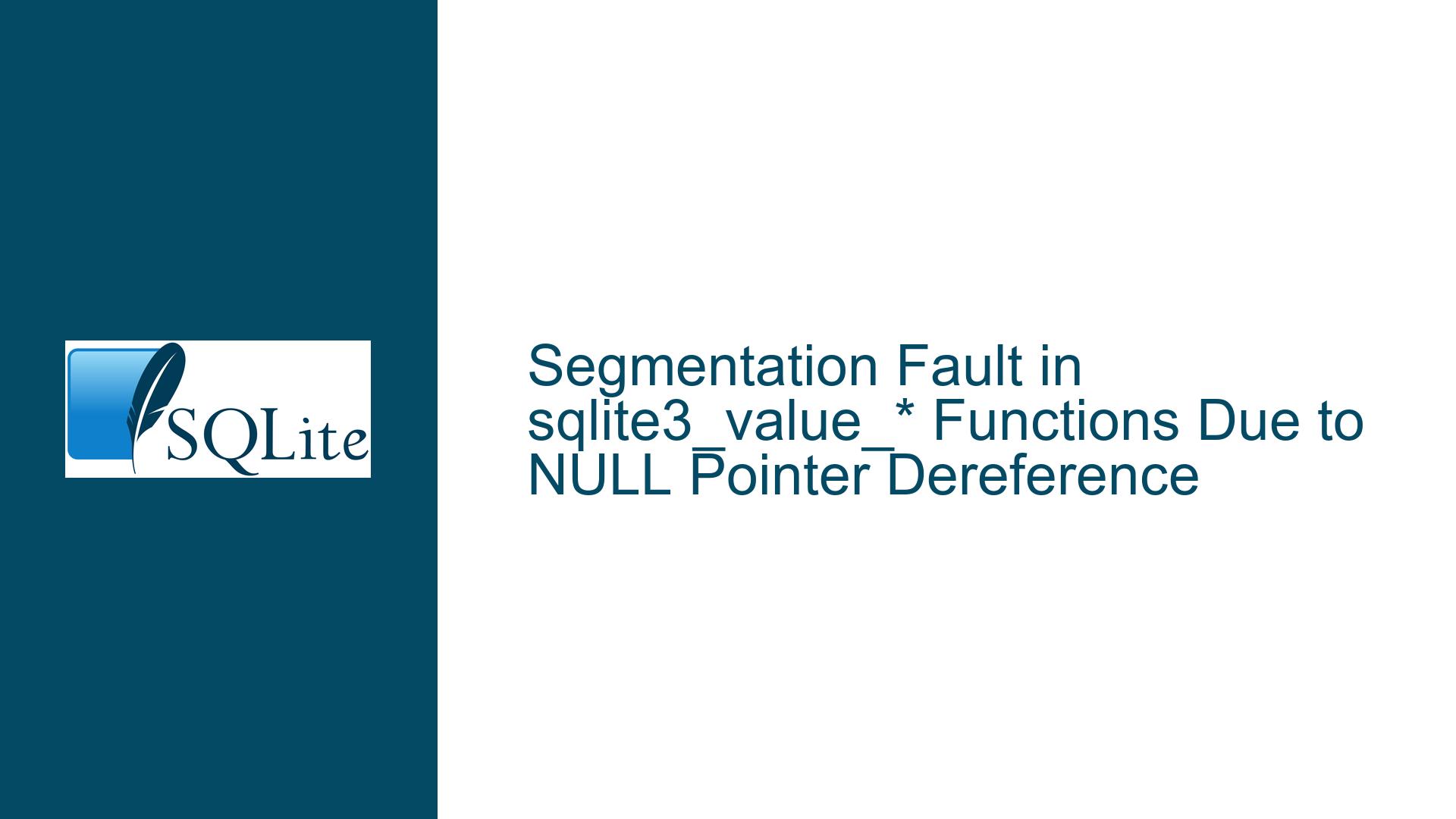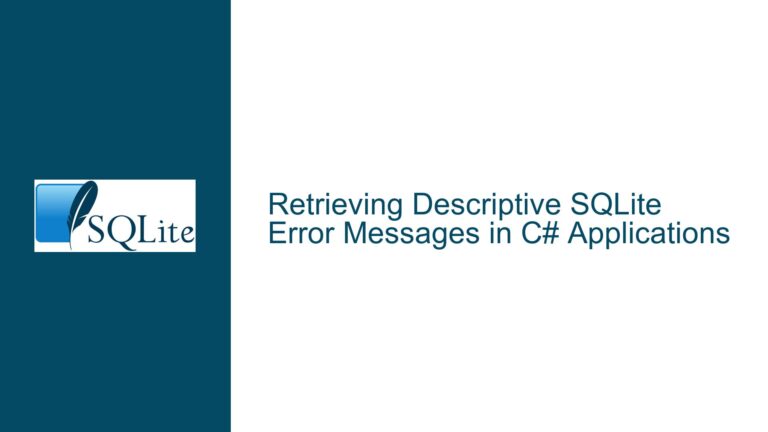Segmentation Fault in sqlite3_value_* Functions Due to NULL Pointer Dereference
Inconsistent NULL Pointer Checks in sqlite3_value_* Function Family Leading to Crashes
The SQLite C/C++ interface provides a suite of functions under the sqlite3_value_* family to extract or compute values from SQL expressions, user-defined functions (UDFs), and virtual tables. These functions are critical for type conversion, data extraction, and memory management. However, an inconsistency exists in how these functions handle NULL pointer arguments, leading to segmentation faults (SigSEGV) when specific functions are called with invalid pointers. This issue arises when functions such as sqlite3_value_bytes, sqlite3_value_bytes16, sqlite3_value_blob, and sqlite3_value_pointer are passed a NULL pointer for their sqlite3_value *pVal parameter.
The core problem stems from the lack of defensive programming practices in these four functions compared to their counterparts. For example, sqlite3_value_text and sqlite3_value_int explicitly check if the input pointer is NULL and return a safe default (e.g., 0, NULL, or an empty string). In contrast, the four affected functions dereference the pVal pointer without validation, causing undefined behavior when the pointer is invalid. This inconsistency violates the principle of least surprise and introduces a reliability risk for applications using these APIs, particularly in edge cases involving custom extensions, fuzzing, or improperly validated inputs.
Root Causes of Missing NULL Checks in Critical sqlite3_value_* APIs
The absence of NULL pointer validation in these functions is not accidental but reflects deeper design decisions and historical implementation patterns within SQLite.
Historical Code Evolution: SQLite’s codebase has evolved over decades, with contributions from numerous developers. Functions like
sqlite3_value_textandsqlite3_value_intwere updated over time to include NULL checks for robustness, while newer or less frequently used functions (e.g.,sqlite3_value_pointer) may not have undergone the same scrutiny. Thesqlite3_value_bytesandsqlite3_value_bytes16functions, which compute the byte length of text values, were likely optimized for performance by omitting checks, assuming that callers would ensure valid pointers.Assumptions About Caller Responsibility: The SQLite API documentation implicitly assumes that
sqlite3_value*parameters passed to UDFs or virtual table methods are valid. For example, when a UDF is invoked, SQLite guarantees that thesqlite3_value**array provided to the function contains valid pointers. However, this guarantee does not extend to scenarios where developers misuse the API (e.g., extracting values from asqlite3_valueobject that has been destroyed or improperly initialized). The lack of NULL checks in certain functions creates a "ticking time bomb" for applications that violate these assumptions.Performance Optimization Trade-offs: Functions like
sqlite3_value_blobandsqlite3_value_bytesare often used in performance-critical contexts, such as processing large BLOBs or text buffers. Adding a NULL check introduces a conditional branch, which might have been deemed unnecessary for internal use cases where the pointer is guaranteed valid. However, this optimization backfires when the API is used outside its intended context.Inconsistent Error Handling Conventions: SQLite’s error reporting mechanisms vary across functions. Some functions return error codes, while others signal errors via NULL pointers or zero values. The
sqlite3_value_*family lacks a unified strategy for handling invalid inputs, leading to confusion about whether a function will tolerate NULL pointers or abort execution.
Mitigating Crashes via Code Validation, Defensive Programming, and API Standardization
To resolve the segmentation faults caused by missing NULL checks, developers must address both immediate crashes and long-term API consistency. Below is a structured approach to diagnosing, fixing, and preventing these issues.
Step 1: Reproducing the Crash in a Controlled Environment
Create a minimal test case that triggers the crash by passing a NULL pointer to the affected functions. For example:
#include <sqlite3.h>
#include <stdio.h>
int main() {
sqlite3_value *null_value = NULL;
// Trigger crash in sqlite3_value_bytes
int bytes = sqlite3_value_bytes(null_value);
printf("Bytes: %d\n", bytes);
return 0;
}
Compile this code against the SQLite library and observe the segmentation fault. This confirms the absence of NULL checks in sqlite3_value_bytes.
Step 2: Auditing SQLite Source Code for NULL Check Patterns
Inspect the SQLite source code to identify which functions perform NULL checks. For example:
- sqlite3_value_text:
const unsigned char *sqlite3_value_text(sqlite3_value *pVal){ if( pVal==0 ) return 0; // ... rest of implementation ... } - sqlite3_value_bytes:
int sqlite3_value_bytes(sqlite3_value *pVal){ return sqlite3ValueBytes(pVal, SQLITE_UTF8); }The latter delegates to
sqlite3ValueByteswithout checkingpVal, leading to a dereference of a NULL pointer insqlite3ValueBytes.
Step 3: Implementing NULL Checks in Affected Functions
Modify the four functions to include explicit NULL checks, mirroring the behavior of other sqlite3_value_* functions. For example:
// Updated sqlite3_value_bytes implementation
int sqlite3_value_bytes(sqlite3_value *pVal) {
if( pVal==0 ) return 0;
return sqlite3ValueBytes(pVal, SQLITE_UTF8);
}
// Updated sqlite3_value_pointer implementation
void *sqlite3_value_pointer(sqlite3_value *pVal, const char *zPType) {
if( pVal==0 ) return 0;
// ... existing logic ...
}
Similar changes apply to sqlite3_value_blob and sqlite3_value_bytes16.
Step 4: Validating Fixes with Unit Tests
Extend SQLite’s test suite (e.g., test1.c or fuzzcheck.c) to include test cases that pass NULL pointers to these functions and verify they return safe defaults instead of crashing. For example:
void test_null_pointer_handling() {
assert( sqlite3_value_bytes(0) == 0 );
assert( sqlite3_value_pointer(0, "type") == 0 );
// ... similar checks for other functions ...
}
Step 5: Assessing Performance Impact
Benchmark the modified functions to ensure the added NULL checks do not introduce measurable overhead. Use tools like perf or valgrind to compare cycle counts and cache performance before and after the changes. In most cases, the cost of a single pointer comparison is negligible compared to the operations performed by these functions (e.g., decoding UTF-16 strings or computing blob lengths).
Step 6: Documenting API Contracts and Error Handling
Update the SQLite documentation to explicitly state which sqlite3_value_* functions tolerate NULL pointers and their return values in such cases. For example:
sqlite3_value_bytes:
This function returns the number of bytes in the text value encoded as UTF-8. If the inputsqlite3_value*is a NULL pointer, the function returns 0.
Step 7: Submitting Patches to the SQLite Project
Contribute the fixes and test cases to the SQLite repository via the official process (email-based patch submission). Engage with maintainers to ensure the changes align with the project’s quality standards and long-term design goals.
Step 8: Adopting Defensive Programming in Application Code
Educate developers using SQLite’s C API to:
- Validate
sqlite3_value*pointers before use, even if the function claims to handle NULL. - Avoid storing or reusing
sqlite3_valueobjects beyond their lifecycle (e.g., after a UDF has returned). - Use SQLite’s error reporting mechanisms (e.g.,
sqlite3_result_error) to signal invalid states instead of relying on NULL pointers.
Step 9: Leveraging Static Analysis and Fuzzing
Integrate static analysis tools (e.g., Clang Analyzer, Coverity) into the build process to detect potential NULL dereferences in SQLite extensions. Use fuzzing frameworks (e.g., libFuzzer, AFL++) to stress-test custom UDFs and virtual table implementations, ensuring they handle edge cases gracefully.
By addressing the inconsistency in NULL pointer handling across the sqlite3_value_* family, developers can eliminate a class of crashes that undermine the reliability of SQLite-based applications. This requires a combination of code fixes, rigorous testing, and updated documentation to align the API’s behavior with user expectations.






